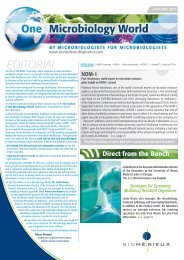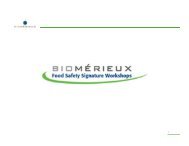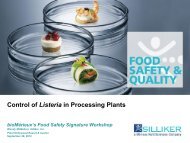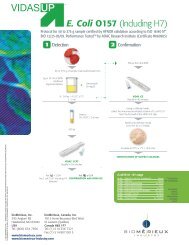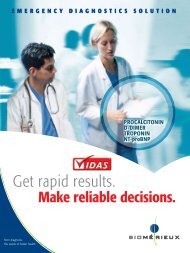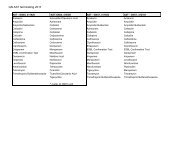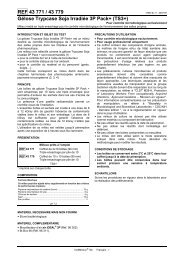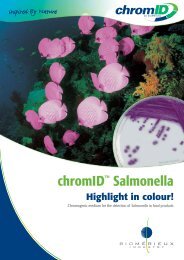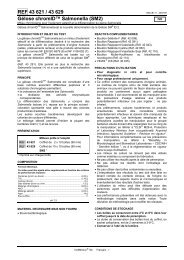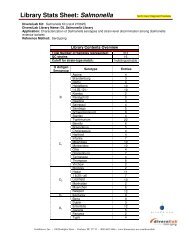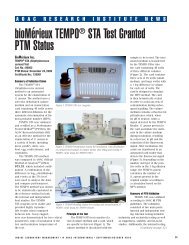Salmonella - bioMerieux
Salmonella - bioMerieux
Salmonella - bioMerieux
You also want an ePaper? Increase the reach of your titles
YUMPU automatically turns print PDFs into web optimized ePapers that Google loves.
A national reference laboratory’s practical<br />
<strong>Salmonella</strong> workflow experience<br />
Ben Howard<br />
Microbiology Laboratory Manager,<br />
Certified Laboratories
Overview<br />
• How do we evaluate platform/method performance?<br />
• What can you do to improve your detection protocol?<br />
• What are the options for result confirmation?<br />
• What is the future of <strong>Salmonella</strong> testing?
Evaluating Performance<br />
• Time to Result<br />
• Cost<br />
• Materials<br />
• Labor<br />
• Ease of Use<br />
• Number transfer steps<br />
• Number of variations between matrices and between targets<br />
• Reliability<br />
• False positives<br />
• False negatives<br />
• No result results
Protocol Overview<br />
• Brief Comparison of Common <strong>Salmonella</strong> Methods<br />
Developer Platform Assay Method Reference<br />
Minimum Time to<br />
Negative Result* (hours) Transfer Steps*<br />
FDA/USDA Cultural Cultural FDA BAM Chpt 5 67-86 4<br />
Difco Cultural BBL CHROMagar AOAC RI# 020502 60 4<br />
DuPont BAX <strong>Salmonella</strong> 2 AOAC 2003.09 30.5 3<br />
DuPont BAX RT <strong>Salmonella</strong> Pending Validation 24.5-28 2-3<br />
3M<br />
MDS<br />
MD <strong>Salmonella</strong><br />
Assay AOAC RI# 031208 20 2<br />
<strong>bioMerieux</strong> VIDAS <strong>Salmonella</strong> (SLM) AOAC 2004.03 49 3<br />
<strong>bioMerieux</strong> VIDAS <strong>Salmonella</strong> (SPT) AOAC RI# 071101 20-24 1<br />
Roka Bioscience Atlas Atlas <strong>Salmonella</strong> AOAC RI# 031208 ~21 1<br />
*Estimates based on reference methods and existing literature, consult manufacturer for more complete<br />
information
Time to Result<br />
• Time from first enrichment to final result<br />
• Includes:<br />
• Minimum enrichment time<br />
• Any transfers (estimated at 30min)<br />
• Post enrichment steps (i.e. lysis or heating block)<br />
• Instrument run time<br />
• Time to Confirmation (if presumptive)
Time to Result cont.<br />
• Example:<br />
• BAX <strong>Salmonella</strong> 2 assay =<br />
• 22 hour enrichment +<br />
• 0.5 hour transfer +<br />
• 3 hour BHI regrowth +<br />
• 0.5 hour transfer +<br />
• 0.5 hour lysis +<br />
• 3.5 hour run time =<br />
• ~30 hour total time to negative result<br />
• If presumptive, add standard cultural confirmation:<br />
• Confirmation: 22 + 44 + 18 + 8 = 92h<br />
• Total time to confirmed result = 122h
Cost (Labor)<br />
• (Time required in man hours to run a single test) x (average<br />
rate of pay for technicians required) = Labor Cost<br />
• Includes:<br />
• Sample login<br />
• Media preparation*<br />
• Sample preparation*<br />
• Transfer steps*<br />
• Instrumentation*<br />
• Confirmation*<br />
• Result entry<br />
• Waste handling<br />
*Areas where labor cost vary widely between methods
Cost (Supplies)<br />
• Supply cost = Manufacturers kit (if applicable) +<br />
media + consumables (pipettes, bags, loops, PPE’s,<br />
waste disposal, sanitizers, etc)<br />
• For rapid detection methods, kit cost is usually the<br />
biggest driver<br />
• Can account for up to 80% of supply cost<br />
• Cost per test = cost per kit/number of tests per kit
Ease of Use<br />
• Ease of use = the overall level of complexity and the<br />
amount of effort required to run/train/maintain a<br />
method.<br />
• Other Ease of Use considerations<br />
• Ability to interface instrument software with LIMS<br />
system<br />
• Consideration may also be made based on the size of the<br />
instrument relative to available lab space
Ease of Use cont.<br />
• Factors contributing to ease of use:<br />
• Number of steps between primary enrichment and<br />
result<br />
• Number of protocols across different matrices<br />
• Frequency of calibration<br />
• Making reagents/media<br />
• Time required to train a new employee<br />
• Time required for a new employee to achieve proficiency
Reliability<br />
• Frequency of Correctness<br />
•1 - (False positives + False Negative + Indeterminate / number<br />
of tests performed) = Frequency of Correctness<br />
• False Positives<br />
• Implication: Cost Time, Money, Client Confidence, Hair Loss<br />
• False Negative<br />
• Implication: Depending on the sample type the impact ranges<br />
from nominal to enormous<br />
• Indeterminate<br />
• Implication: Costs time and money, can delay action
False Negatives<br />
• <strong>Salmonella</strong> present but not detected<br />
• Causes:<br />
• Matrix inhibition in enrichment (i.e. spices)<br />
• High-background microflora masks/inhibits target organism<br />
• Matrix interference with replication process (i.e. PCR reaction)<br />
• Instrumentation error or failure<br />
• Lab error (i.e. expired media)<br />
• Prevention:<br />
• Validate new matrices and formulations to ensure compatibility<br />
• Run a positive and negative control for each variation of a methods<br />
protocol
“False” Positives<br />
• What is a false positive?<br />
• Example 1:<br />
• Rapid Screen: presumptive<br />
• Culture Confirmation: negative<br />
• Example 2:<br />
• Rapid Screen: presumptive<br />
• Cultural Confirmation: positive<br />
• Strain typing reveals exact match with positive control strain<br />
or another positive from a different sample set on the same<br />
run
Confirmations - Overview<br />
• Why do you confirm?<br />
• Rule out lab/instrument error<br />
• Obtain an isolate for further analysis (i.e. strain typing)<br />
• Good old fashioned CYA<br />
• What are your options?<br />
• No confirmation at all<br />
• Cultural confirmation<br />
• Cross-platform confirmation<br />
• Hybrid of the two
Confirmation – Schmonfirmation<br />
• If:<br />
• Your response protocol does not change depending on<br />
the outcome of the confirmation OR…<br />
• The corrective action will be complete by the time the<br />
confirmation result is available AND…<br />
• You do not perform any further analysis on recovered<br />
isolates AND…<br />
• You do not have reason to suspect lab error was the<br />
cause of the result…<br />
You may opt not go through with confirmation.
Confirmation Options (Cultural)<br />
• Cultural Confirmations<br />
• Full FDA cultural confirmation<br />
• Time to result from primary enrichment (86h)<br />
• Plus serological (O and H antigens)<br />
• USDA/FSIS<br />
• Time to result from primary enrichment (80h)<br />
• Plus serological (O and H antigens)<br />
• Difco confirmation with BBL CHROMagar<br />
• Time to result (40h)<br />
• Plus serological (O and H antigens)
Confirmation Options (Cultural)<br />
• Advantages<br />
• Allows for the recovery of an isolate<br />
that can be used for further analysis<br />
• Strain typing to rule out lab error<br />
• Strain typing to track contamination spread<br />
• Helpful with determination of appropriate<br />
organisms for challenge studies<br />
• Warm and fuzzy satisfaction in seeing<br />
your typical isolate
Confirmation Options (Cultural)<br />
• Disadvantages:<br />
• Not as sensitive as rapid methodology<br />
• Background microflora frequently masks typical<br />
colonies on selective agar<br />
• Many strains are atypical on selective agar<br />
• Time to confirmed positive result is considerably longer<br />
than time to negative<br />
• Negative cultural confirmation does not erase the initial<br />
presumptive
Alternative Confirmation Options:<br />
• Cross-platform Verification<br />
• Two platforms with different detection targets<br />
• DNA<br />
• Protein<br />
• Different “weaknesses” in one may not be present in the<br />
other<br />
• Cross-reactivity with PCR<br />
• Cross-reactivity with Immunoassay<br />
• Cross-reactivity with Phage
Alternative Confirmation Options:<br />
• Advantages<br />
• Much faster time to confirm<br />
• Similar high level of sensitivity<br />
• Odds of two false presumptive results from platforms<br />
with different targeting mechanisms is very low<br />
• Can still take on to selective broths and agars to recover<br />
an isolate
Alternative Confirmation Options:<br />
• Disadvantages<br />
• No isolate unless taken through at least partial cultural<br />
method<br />
• Will not allow for determination of cross-contamination<br />
events<br />
• As with cultural confirmation, a negative result on the<br />
cross-check platform does not erase the original<br />
presumptive
Confirmation – Hybrid<br />
• Combining cultural and crossplatform<br />
confirmation<br />
• Developing your own protocol<br />
• Example 1:<br />
• If presumptive on ELFA, run PCR<br />
• If presumptive on PCR begin<br />
presumptive response SOP<br />
• If negative on PCR wait for cultural<br />
confirmation<br />
• Either way, initiate cultural<br />
confirmation<br />
• If negative on PCR and via cultural …<br />
refer to false positive SOP
Validation<br />
• When is it worth it?<br />
• Significant improvement to cost, time, reliability<br />
• When do you need to do it?<br />
• When you lack the data supporting the viability of<br />
method with a particular matrix<br />
• When you make adjustments to the reference method<br />
• How do you do it?<br />
• Internally<br />
• Externally: Send it to Certified Laboratories (or another<br />
accredited reference laboratory)
<strong>Salmonella</strong> in the Crystal Ball<br />
• 2015 – Rapid detection platforms finally realize the potential of<br />
multiplex technology and include a marker for internal control<br />
strains to detect positive control contamination and wild-types<br />
simultaneously<br />
• 2022 – Smart phone app allows users to test for pathogens in<br />
food and food by-products and upload results to the popular<br />
online social networking site “MyFace”, in a matter of seconds<br />
• 2023 – Routine testing labs take on a reduced role in <strong>Salmonella</strong><br />
testing (continues to survive on study work, consulting, and free<br />
lunches provided by the remaining rapid detection platform<br />
vendors)
Predictions Continued<br />
• 2033 – FDA approves a <strong>Salmonella</strong> destroying<br />
phage for use on food products and ingredients<br />
• 2034 - New mutated <strong>Salmonella</strong> strain discovered<br />
that turns affected into catnip craving zombies. A<br />
terrible, if not playful, zombie apocalypse ensues.
Questions?



